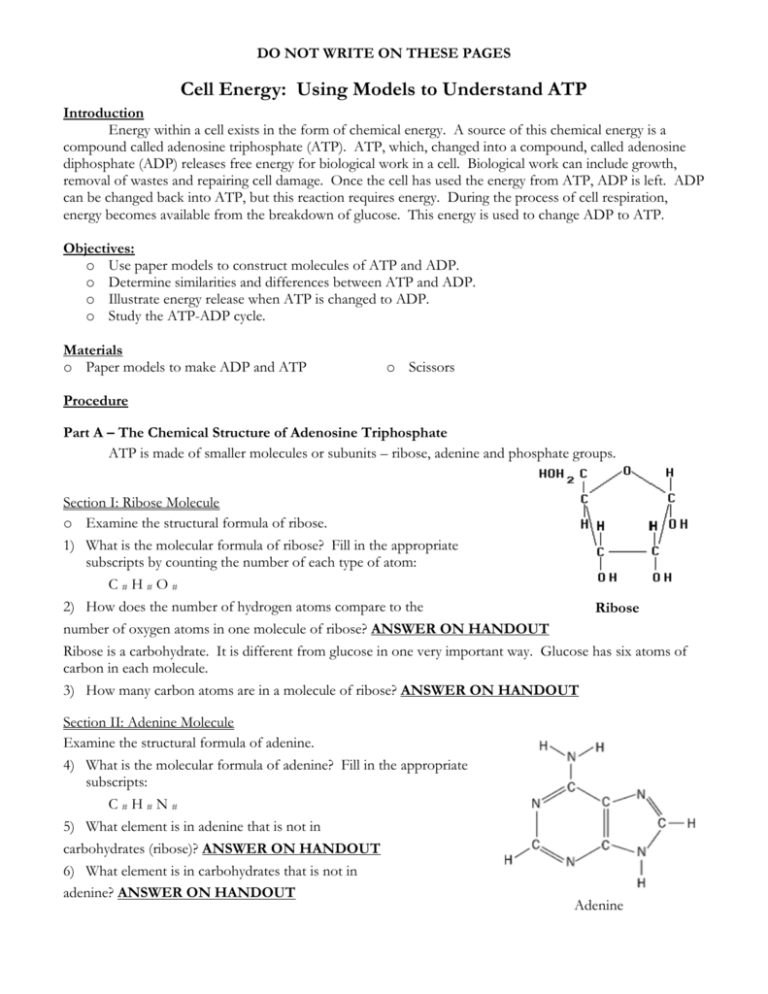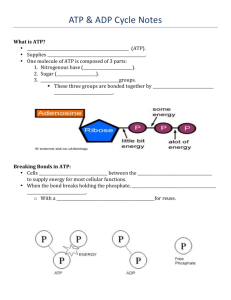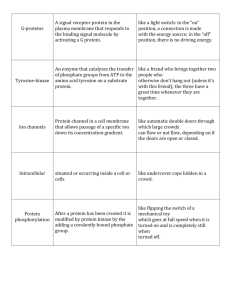Directions
advertisement

DO NOT WRITE ON THESE PAGES Cell Energy: Using Models to Understand ATP Introduction Energy within a cell exists in the form of chemical energy. A source of this chemical energy is a compound called adenosine triphosphate (ATP). ATP, which, changed into a compound, called adenosine diphosphate (ADP) releases free energy for biological work in a cell. Biological work can include growth, removal of wastes and repairing cell damage. Once the cell has used the energy from ATP, ADP is left. ADP can be changed back into ATP, but this reaction requires energy. During the process of cell respiration, energy becomes available from the breakdown of glucose. This energy is used to change ADP to ATP. Objectives: o Use paper models to construct molecules of ATP and ADP. o Determine similarities and differences between ATP and ADP. o Illustrate energy release when ATP is changed to ADP. o Study the ATP-ADP cycle. Materials o Paper models to make ADP and ATP o Scissors Procedure Part A – The Chemical Structure of Adenosine Triphosphate ATP is made of smaller molecules or subunits – ribose, adenine and phosphate groups. Section I: Ribose Molecule o Examine the structural formula of ribose. 1) What is the molecular formula of ribose? Fill in the appropriate subscripts by counting the number of each type of atom: C#H#O# 2) How does the number of hydrogen atoms compare to the Ribose number of oxygen atoms in one molecule of ribose? ANSWER ON HANDOUT Ribose is a carbohydrate. It is different from glucose in one very important way. Glucose has six atoms of carbon in each molecule. 3) How many carbon atoms are in a molecule of ribose? ANSWER ON HANDOUT Section II: Adenine Molecule Examine the structural formula of adenine. 4) What is the molecular formula of adenine? Fill in the appropriate subscripts: C#H#N# 5) What element is in adenine that is not in carbohydrates (ribose)? ANSWER ON HANDOUT 6) What element is in carbohydrates that is not in adenine? ANSWER ON HANDOUT Adenine DO NOT WRITE ON THESE PAGES Section III: Phosphoric acid (Phosphate group) o Examine the structural formula of phosphoric acid, also known as phosphate. The term phosphoric acid can be used interchangeably with the term phosphate. NOTE: The letter P represents the element phosphorus. 7) What is the molecular formula of phosphate? Fill in the appropriate subscripts: H#P#O# Phosphoric acid (Phosphate) Section IV: Constructing an ATP Molecule An ATP (adenosine triphosphate) molecule is made up of one ribose molecule, one adenine molecule and three phosphate groups chemically joined. 8) What does the prefix “tri” in triphosphate mean? ANSWER ON HANDOUT Adenosine is a word made up of a combination of letters from two different words. Part of the word, the letters “os,” comes from ribose. 9) Where do the letters “aden” and “ine” come from? ANSWER ON HANDOUT o Locate the paper models. These represent the building blocks of ATP/ADP. Notice the solid lines around the perimeter of each of the five pieces. Notice also that each piece has some dashed lines inside. o Cut out one of the boxes containing a set of models. Cut out the individual pieces inside the box. Cut along the solid lines so that you have five pieces. Do not cut the dashed lines at this time. o Think of these as puzzle pieces. Attempt to join the adenine and ribose molecules as you would the pieces of a puzzle. Notice that they will lie next to each other but one does not fit into the other. In order to fit into each other, you must cut along the dashed lines in adenine and one of the dashed lines in ribose. 10) What end parts did you remove from the adenine and ribose in order to fit them together? ANSWER ON HANDOUT 11) Look at the end parts you removed; what molecule is formed when you combine these parts? ANSWER ON HANDOUT o Combine the adenine and ribose. You now have the “adenosine” portion of the ATP molecule. Use tape to attach these pieces together. o Attempt to attach one of the phosphate molecules to the ribose end of your adenosine molecule. 12) What end pieces must you first remove before you can combine these pieces? ANSWER ON HANDOUT o Using tape, attach the three phosphate molecules so you have a chain of three phosphate molecules off the ribose. 13) What did you remove to make these connections? ANSWER ON HANDOUT You have now built an ATP molecule. 14) How many of the molecules stated in Question 15 did you have to remove in order to create one molecule of ATP? ANSWER ON HANDOUT DO NOT WRITE ON THESE PAGES 15) List the “building blocks” that are needed to form one ATP molecule in the table below. Indicate how many of each you used to make one molecule of ATP. Building Block # Needed in ATP ANSWER ON HANDOUT ANSWER ON HANDOUT ANSWER ON HANDOUT ANSWER ON HANDOUT ANSWER ON HANDOUT ANSWER ON HANDOUT 16) Look back at the introduction; what substance is needed in order for these parts to combine? ANSWER ON HANDOUT Part B – Releasing Energy from ATP as it Changes to ADP o Remove one phosphate group from the end of your ATP molecule. When cells do work, they get energy released when one phosphate is removed from ATP. 17) How many phosphate groups are still attached to the original molecule? ANSWER ON HANDOUT This new compound, with one fewer phosphate group that before, is called adenosine diphosphate (ADP). 18) Look at this molecule to determine what the prefix “di” means. ANSWER ON HANDOUT 19) List the “building blocks” that are needed to form one ADP molecule. Indicate how many of each you used to make your one molecule of ADP. Building Block # Needed in ADP ANSWER ON HANDOUT ANSWER ON HANDOUT ANSWER ON HANDOUT ANSWER ON HANDOUT ANSWER ON HANDOUT ANSWER ON HANDOUT 20) Explain how one ATP molecule is changed into one ADP molecule. ANSWER ON HANDOUT 21) Look back at the introduction; what substance is released when ADP is formed? ANSWER ON HANDOUT So far we have seen that ATP can be changed to ADP with energy given off. This change can be written using a type of shorthand. For example, this change may be written as follows: ATP becomes ADP + Phosphate group + E 22) What might the letter “E” be an abbreviation for in the above equation? ANSWER ON HANDOUT Part C – Changing ADP to ATP ATP can be formed within living organisms if the correct raw materials are available. These raw materials are: ADP, phosphate group and energy. We can again use models to help show how ATP is formed. o Using the other set of models on the last page of this packet, construct an ADP molecule. o Attach a phosphate group to the ADP model. If necessary, remove any “H” or “OH” ends to provide the point of attachment. Energy is needed to change ADP back to ATP. Using a type of shorthand, this change can be written as follows: becomes ADP + Phosphate group + E ATP 23) What might the letter “E” be an abbreviation for in the above equation? ANSWER ON HANDOUT DO NOT WRITE ON THESE PAGES Part D – An Energy Source for Converting ADP to ATP Where does the energy come from to form ATP from ADP? It does not come from the energy released when ATP changes to ADP. The energy comes from a different source. Energy is “stored” in all compounds. Food such as glucose contains much energy; glucose is the major source of energy for ATP formation. Energy is released from glucose during a process called cellular respiration. o Examine the structural formula for glucose shown in the equation at the top of the next page. In cellular respiration, glucose is broken down into two identical molecules of a chemical called pyruvic acid. This step is called glycolysis (“glyco-” = glucose; “-lysis” = break apart). Glycolysis is the first step in cellular respiration. The lines that connect one atom to another represent chemical bonds. A double bond is represented by a double line like this: II. Glucose Pyruvic acid Pyruvic acid 24) Count and record the number of bonds in: a. one molecule of glucose ANSWER ON HANDOUT b. two molecules of pyruvic acid ANSWER ON HANDOUT NOTE: Be sure to count double lines as two bonds and all other lines as one bond. 25) Is the total number of bonds in one glucose molecule the same as the total number of bonds in two pyruvic acid molecules? ANSWER ON HANDOUT 26) Is the amount of energy in one glucose molecule the same as the energy in two pyruvic acid molecules? ANSWER ON HANDOUT 27) Look back at the introduction. How is some of this extra energy used by a cell? ANSWER ON HANDOUT Pyruvic acid is broken down further to yield more energy. Energy released from glucose during cellular respiration is used to build more molecules of ATP. Data Analysis/Conclusion: ANSWER ON HANDOUT





